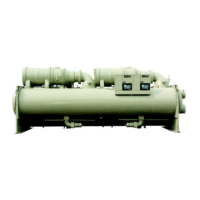Product Manual PM WSC/WDC 5
HFC-134a:
Helping To Keep The Ozone Whole!
McQuay Positive Pressure Design:
No Purge
No Vacuum Prevention System
No Contaminants
HFC-134a operates above atmospheric pressure in the entire refrigerant circuit. Negative (low) pressure
systems require a purge unit to remove non-condensables (air, water vapor, etc.) that leak into the chiller during
operation and compromise chiller performance. Purge units, even the new "high efficiency" types, regularly
have to vent refrigerant to the atmosphere, along with the non-condensables. The 1990 Clean Air Act has
prohibited the intentional venting of refrigerant since July 1, 1992. The environmentally responsible positive
pressure system eliminates this regular venting of refrigerant.
Great care is taken by manufacturers and service personnel to ensure that refrigeration systems are dry when
they are manufactured or serviced. It makes no sense at all to buy a negative pressure HCFC-123 chiller that
ingests water vapor during normal operation.
In addition to the refrigerant loss and maintenance problems of a purge system, negative pressure chillers
require a vacuum prevention system. This system heats the refrigerant during off cycles to a positive pressure.
Unfortunately, the vacuum prevention system only works when the chiller is off, and cannot prevent vacuum
related problems when the chiller is operating. Plus, it’s a heating system requiring energy.
Sustainable Performance
Because of their positive pressure design, McQuay centrifugal chillers offer greater sustainable performance
over the life of the chiller. Positive pressure means no intrusion of noncondensable gases that are known as
"robbers" of efficiency. These foreign gases compete with refrigerant for heat exchange surface and can reduce
efficiency by as much as 14% at full load.
Positive pressure eliminates oil degradation due to non-condensables. Contaminated oil will produce acids that
attack and breakdown motor insulation and copper plate shafts and bearings. The contaminant free, extended
life lubricant used in McQuay chillers offers a means to gauge the health of your machine over the years.
Through diagnostic analysis methods available for synthetic lubricants, preventative action can be taken
should a potential problem show itself.
No purge system to...
• Attack the ozone,
• Escalate operating costs,
• Increase annual maintenance,
Chiller systems utilizing negative pressure refrigerants are subject to the continuous introduction of equipment
room moisture and non-condensables into the refrigerant circuit. Bolted surfaces, vane operator linkage outlets,
motor terminals, control tubing connections and casing porosity all provide points of entry for the introduction
of these foreign gases into the circuit. This can be especially destructive in maritime locations where salt laden
air is present. These non-condensables must be isolated, collected and purged continuously from the
equipment.

